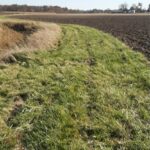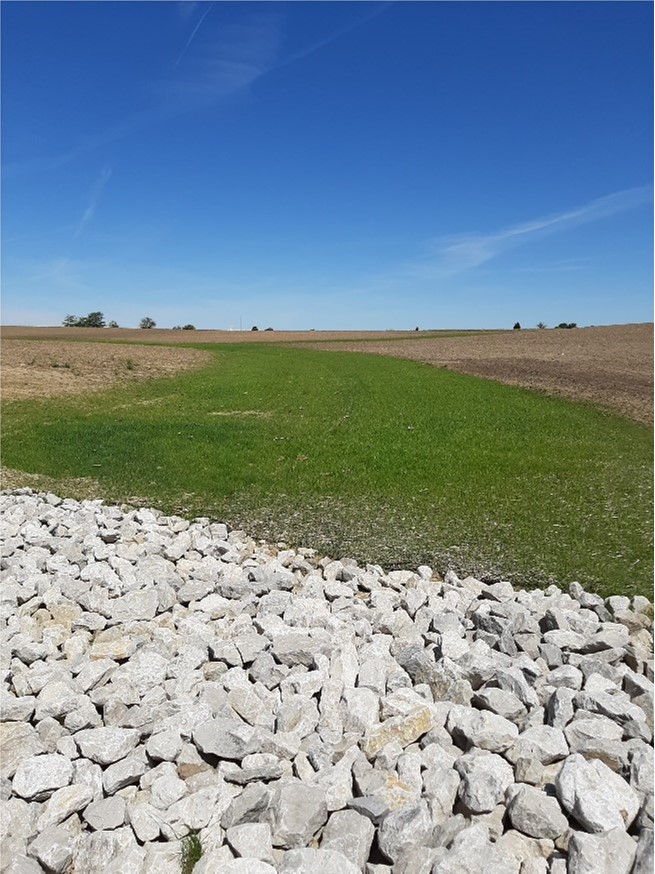Conservation Best Management Practices
Grassed Waterway – Grassed waterways are
constructed shallow channels, permanently seeded to grass that convey surface water
across a crop field. Grass waterways
protect soil from gully erosion and reduce sediment and nutrient runoff.
Grade Stabilization Structure – these
structures are often made of large angular rock, called rock chutes. These chutes control the passage of water
through a sudden drop in elevation, reducing the erosive force of the water on
the stream bank. Often rock chutes are paired
with grassed waterways that outlet into a stream or ditch. Drop structures
are another grade stabilization structure that are used to transition water
quickly. These structures can me made of
treated lumber, concrete or manufactured pipe.
Grass Filter Strip – Filter strips are strips
– Filter strips are strips
of grass planted parallel to a watercourse or surrounding a body of water or a
well. They filter runoff and remove
contaminants before they reach the water source. They can also reduce erosion of soil along
the water body as well as provide wildlife habitat.
Riparian Tree Buffer – Riparian buffers are
groups of trees planted along a watercourse or around a body of water that
reduce. They filter and remove
contaminants before they reach the water source. They help reduce erosion and provide
wildlife habitat.
Manure Storage Structure –  Manure storage
Manure storage
structures store manure nutrients in a controlled environment until they can be
applied sustainably on cropland. Types
of manure storage structure vary depending upon whether the manure to be stored
is liquid or solid manure. Concrete structures
with a roof are common for solid manure and tanks or earthen structures are
more common with liquid manure.
Nutrient Management Plan – Nutrient management
plans manage the 4R’s of fertilizer applications – the right rate, at the right
time, in the right place and with the right source. Nutrient management plans are written to help
producers plan applications of commercial fertilizer, manure, biosolids and/or
compost to maximize crop production and improve water quality.
Cover Crop – Cover crops such as cereal rye,
clover, oats and winter wheat are planted to temporarily protect the soil from
wind and water erosion during times when commodity crops- like corn and
soybeans- are not being grown in the field. Cover crops that survive the winter months
also supply living roots that benefit soil ecology. Cover crops can also trap and store nutrients
and reduce weeds.
Prescribed Grazing – Often called intensive
grazing, rotational grazing or mob grazing, prescribed grazing manages the
harvest of forage with grazing or browsing livestock. Often large pastures are divided into smaller
paddocks with electric fence and livestock are moved from paddock to paddock on
a schedule based on forage availability and livestock nutritional needs.
Tree Windbreak – Tree windbreaks are single or
– Tree windbreaks are single or
multiple rows of trees and shrubs strategically designed and placed to protect
areas from wind. Most windbreaks include
species of evergreen trees so that they provide relief all year. Windbreaks are installed to protect topsoil in
cropland from wind erosion, provide wind relief for livestock, reduce wind
velocity around farmsteads and as living snow fences to control drifting
snow. They also provide wildlife
habitat, especially during winter.
Wetland – Wetlands are areas of saturated
soils and water-loving plants. They vary
widely in size and shape and can consist of a variety of plants – including
grasses, sedges, shrubs and/or trees. Often
referred to as the “kidneys of the earth”, wetlands improve water quality by
filtering contaminants like chemicals or sediment. They may or may not hold water all year long
as some are intermittent, only holding water during wetter periods. Wetlands may provide flood relief and provide
ground water recharge as well. Many
species of wildlife depend on wetlands for food and habitat.
Conservation Tillage – Conservation tillage
includes no-till, strip till and mulch till planting
practices. No-till is a planting method
with no tillage of the soil prior to planting, leaving 100% of the previous
crop residue on the soil surface. Strip
Till is a planting method where tillage is only done in narrow strips
across the field, leaving the area between the strips untilled. Crops and nutrients are then placed into the
tilled strips. Mulch till is a
planting method with minimal tillage prior to planting, leaving at least 30% of
the previous crop residue at the surface.
Conservation tillage practices improve soil quality by reducing soil
erosion and increasing soil organic matter and soil tilth.
